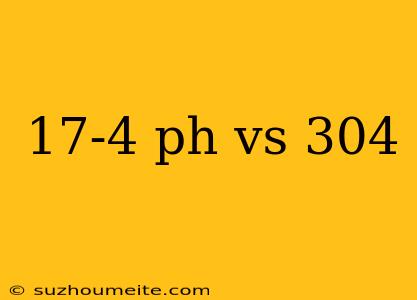17-4 PH vs 304: What's the Difference?
When it comes to stainless steel, there are numerous types to choose from, each with its unique characteristics, advantages, and disadvantages. Two popular types of stainless steel are 17-4 PH and 304. While both are widely used in various industries, they have distinct differences in terms of composition, properties, and applications.
Composition
17-4 PH
17-4 PH is a type of precipitation-hardening stainless steel that contains:
- 15.5% to 17.5% Chromium (Cr)
- 3.0% to 5.0% Nickel (Ni)
- 3.0% to 5.0% Copper (Cu)
- 0.3% to 1.0% Molybdenum (Mo)
- 0.5% to 1.0% Manganese (Mn)
- 0.03% to 0.07% Carbon (C)
304
304 is a type of austenitic stainless steel that contains:
- 18.0% to 20.0% Chromium (Cr)
- 8.0% to 12.0% Nickel (Ni)
- 2.0% Manganese (Mn)
- 1.0% Silicon (Si)
- 0.08% Carbon (C)
- Trace amounts of phosphorus, sulfur, and nitrogen
Properties
17-4 PH
- High strength-to-weight ratio
- Excellent corrosion resistance, especially in marine environments
- Good weldability and machinability
- High hardness and resistance to wear and abrasion
- Non-magnetic
304
- Excellent corrosion resistance, especially in chemical environments
- High ductility and formability
- Good weldability and machinability
- Low thermal conductivity
- Non-magnetic
Applications
17-4 PH
- Aerospace industry (engine components, fasteners, and structural components)
- Marine industry (propeller shafts, fittings, and hardware)
- Chemical processing equipment (valves, pumps, and piping)
- Oil and gas industry (downhole equipment and tubing)
304
- Food processing equipment (dairy, brewery, and winery)
- Chemical processing equipment (reactors, tanks, and piping)
- Marine industry (piping, fittings, and hardware)
- Construction industry (handrails, door handles, and architectural features)
Conclusion
In conclusion, while both 17-4 PH and 304 are high-performance stainless steels, they have distinct differences in terms of composition, properties, and applications. 17-4 PH is ideal for high-strength, high-temperature applications where corrosion resistance and wear resistance are critical, such as in the aerospace and marine industries. On the other hand, 304 is suitable for applications where high ductility, formability, and corrosion resistance are required, such as in food processing, chemical processing, and construction industries.
